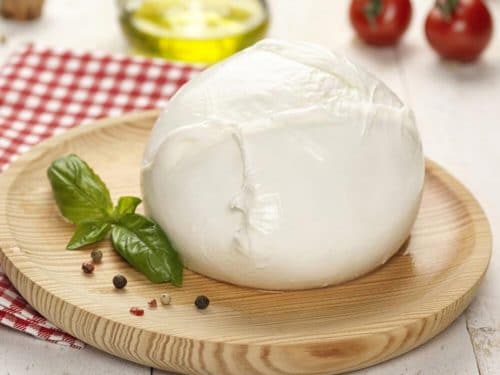Discover the joy of making homemade Mozzarella with our step-by-step guide. From curdling to shaping, unlock the secrets to achieving the perfect stretchy texture and delicate flavour. Join us on a cheesy adventure as we delve into the world of DIY Mozzarella. Let’s get started!

About Mozzarella
Mozzarella is a popular Italian cheese known for its smooth texture and mild, milky flavour. It originated in the region of Campania, Italy, and is traditionally made from the milk of water buffaloes.
However, today, it is commonly produced using cow’s milk as well. The process of making mozzarella involves heating the milk and adding a coagulating agent, such as rennet, to form curds.
The curds are then stretched and kneaded to develop the characteristic stretchy and elastic texture of mozzarella. Finally, the cheese is shaped into balls or logs and immersed in a brine solution to enhance its flavour and preservation.
Ingredients You Need
Fresh Milk
For optimal results, I highly recommend using fresh, whole raw milk. Its rich and creamy nature contributes to the best outcome when making Mozzarella.
However, if raw milk is not accessible, you can still utilize skimmed milk (2% and similar) as an alternative, although it may lack the same level of creaminess and richness.
Pasteurised milk is also a viable option, but it’s important to avoid homogenised or ultra-pasteurised milk as they are not suitable for the Mozzarella-making process.
Other Ingredients
Rennet: You can use rennet tablets or liquid rennet (which allows you to skip a step).
Citric Acid: The curdling agent I prefer to use is citric acid, as it has consistently provided me with the best results in my experiments. It is crucial to achieve the right level of acidity, as insufficient acidity can impede the stretching ability of the cheese, while excessive acidity can result in a grainy and lumpy texture. Therefore, finding the perfect balance is essential for optimal outcomes.
Cheese Salt: You can use any type of salt as long as it does not contain any Iodine. The reason for this is because Iodine will inhibit the growth of cultures and bacteria in the milk.
Water: You will need water to dissolve your rennet (if using powder or tablets) and citric acid.
Equipment You Need
Instant Read Thermometer: If you’ve got years of experience in making cheese, you may not need a thermometer. But it is highly recommended for beginner and intermediate level cheesemakers.
Palette Knife: This type of knife does not have a sharp edge. It will allow you to easily cut through the curd without damaging your pot.
Slotted Spoon Ladle: The ladle will allow you to transfer your initial curd into a colander to draw out some of the whey.
Rubber Gloves (optional): Whether you need rubber gloves will really come down to whether you are comfortable with handling hot whey and curd.
Complete Cheesemaking Steps
- Mix rennet with water in a small bowl.
- Dissolve citric acid in the remaining half a cup of water in a second small bowl.
- Pour milk into a large pot set over medium heat. Add in citric acid solution.
- Heat milk, stirring occasionally, until it reaches 32°C (or 90°F) on an instant-read thermometer. This should take about 5 minutes.
- Remove milk from heat and stir in rennet mixture in a figure-8 motion for 30 seconds. Stir anti-clockwise for 30 seconds to steady the milk.
- Rest, covered, until curds are formed. This should take 5 to 10 minutes. Check firmness with the back of a spoon.
- Slice vertically into the pot to cut the curd into 2 cm (3/4 inch) cubes using the palette knife. Stir curds gently and be careful not to break the cubes.
- Return pot to the heat and cook over medium heat. Gently stir the curds, until temperature reaches 43°C (or 109°F). This should take about 5 minutes. Remove from heat.
- Using the ladle, transfer the curds carefully into a colander set over a large bowl. Gently press the curds to release some liquid whey. Pour the whey back into the pot.
- Heat whey to 85°C (or 185°F), about 5 minutes. Wearing gloves, tear off a piece of curd and place it in the slotted spoon. Dip into hot whey for about 10 seconds.
- Stretch the curd and gently knead it. Repeat until the Mozzarella is smooth and elastic. Add in salt and shape the cheese into a ball. Repeat this step with the remaining curd.
- Allow Mozzarella to cool and store in whey solution in an airtight container.
How to serve Mozzarella
Mozzarella is widely used in Italian cuisine and is a key ingredient in dishes like Caprese Salad, pizza and lasagne. Its soft and creamy texture, along with its mild taste, makes it a versatile cheese that pairs well with a variety of ingredients.
The cheese is often enjoyed in its uncooked form, adding a creamy and indulgent element to salads and sandwiches. It can also be melted and used as a topping for pizzas or as a filling for pasta dishes, bringing a rich, gooey texture and a mild, milky taste to the final creation.
Cheesemaking FAQs
There are some of the most frequently asked questions about making Mozzarella at home.
Can I use pasteurised milk to make Mozzarella?
Yes, pasteurised milk can be used to make Mozzarella. However, avoid using ultra-pasteurised or homogenised milk.
Can I use vinegar instead of citric acid?
Yes, you can use vinegar. I would recommend white distilled vinegar and you will need to adjust the amount you use. Most recipes call for about 100 ml (or 7 tbsp) of white vinegar.
Can I use a microwave instead of hot water to stretch the Mozzarella curds?
Yes, some recipes offer microwave methods for stretching Mozzarella curds as an alternative to hot water. However, traditional hot water stretching is more commonly recommended for better results.
How should I store homemade Mozzarella?
Freshly made Mozzarella is best enjoyed immediately. If storing, place it in a container with some whey or a brine solution and keep it refrigerated for up to a week.
Why is my homemade Mozzarella grainy or rubbery?
Grainy or rubbery texture can be caused by overcooking the curds, excessive acidification or improper stretching techniques. Ensure proper temperature control and follow the recipe instructions carefully for the desired texture.
Printable Recipe Card

How to Make Mozzarella
Equipment
- Instant Read Thermometer
- Palette Knife
- Slotted spoon ladle
Ingredients
- 4.5 litres milk cow's or buffalo milk
- 1/4 tsp liquid rennet
- 1.5 tsp citric acid powder
- 1 tsp salt
- 3/4 cup water
Instructions
- Mix rennet with water in a small bowl.1/4 tsp liquid rennet, 3/4 cup water
- Dissolve citric acid in the remaining half a cup of water in a second small bowl.1.5 tsp citric acid
- Pour milk into a large pot set over medium heat. Add in citric acid solution.4.5 litres milk
- Heat milk, stirring occasionally, until it reaches 32°C (or 90°F) on an instant-read thermometer. This should take about 5 minutes.
- Remove milk from heat and stir in rennet mixture in a figure-8 motion for 30 seconds. Stir anti-clockwise for 30 seconds to steady the milk.
- Rest, covered, until curds are formed. This should take 5 to 10 minutes. Check firmness with the back of a spoon.
- Slice vertically into the pot to cut the curd into 2 cm (3/4 inch) cubes using the palette knife. Stir curds gently and be careful not to break the cubes.
- Return pot to the heat and cook over medium heat. Gently stir the curds, until temperature reaches 43°C (or 109°F). This should take about 5 minutes. Remove from heat.
- Using the ladle, transfer the curds carefully into a colander set over a large bowl. Gently press the curds to release some liquid whey. Pour the whey back into the pot.
- Heat whey to 85°C (or 185°F), about 5 minutes. Wearing gloves, tear off a piece of curd and place it in the slotted spoon. Dip into hot whey for about 10 seconds.
- Stretch the curd and gently knead it. Repeat until the Mozzarella is smooth and elastic. Add in salt and shape the cheese into a ball. Repeat this step with the remaining curd.
- Allow Mozzarella to cool and store in whey solution in an airtight container
Notes
Such an easy recipe. I love mozzarella and it is so awesome to be able to make it myself.
Hi, recipe looks simple enough but what I need to know is instead of Rennet and Citric Acid can I use Vinegar for the milk and kosher salt to the whey?